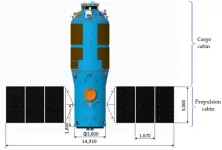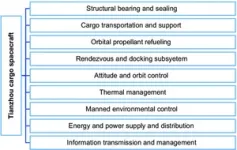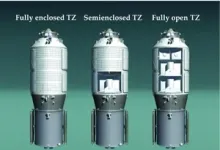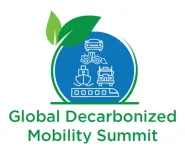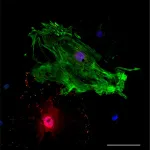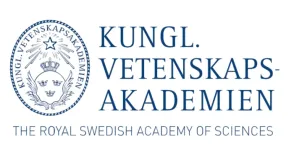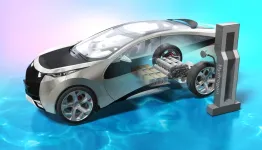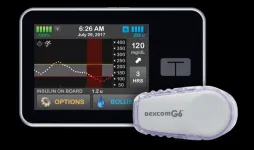Cargo spacecraft is robotic spacecraft designed to support space station operation by transporting food, propellant and other supplies. Tianzhou cargo spacecraft (The abbreviation is TZ) is a Chinese automated cargo spacecraft developed by the China Academy of Space Technology, as part of China's manned space Station program. The China Academy of Space Technology began to design TZ in 2010. Its main tasks are transporting and storing supplies for the space station, storing and descending waste materials for the space station, controlled falling to a predetermined area; cooperating with the space station to control the orbit and attitude of the combined body; Supporting the development of space applications and technical tests adapted to the capabilities of cargo spacecraft. In a review paper recently published in Space: Science & Technology, Jianyu Lei, from China Academy of Space Technology, presented a detailed description about the design of Tianzhou Cargo Spacecraft including the structure, function, and key technology of subsystems. The development and flight missions were also demonstrated. A comparison of TZ with other cargo vehicles were made, which provides us a systematic understanding about TZ cargo spacecraft.
Firstly, the author presented the details of manufacture and design for the Tianzhou cargo spacecraft. China's TianGong (TG) space station only has TZ as a cargo vehicle. TZ has broken through key technologies such as cargo transportation, propellant replenishment, and fully autonomous rapid rendezvous and docking. A distinctive feature of the TZ is its capacity for transporting pressurized cargo and unpressurized cargo, refueling propellant, boosting the TG orbit, supporting specific space experiments. The spacecraft consists of two modules: a cargo cabin for transporting pressurized cargo, a propulsion cabin with aviation electronics and propulsion function. It is about 10.6 m long (including maneuvering thrusters at one end) and 3.35 m in diameter. The total mass of the cargo spacecraft is 7 t with a maximum total payload of 6.5 t. Pressurized cargo loaded in the cargo cabin includes clothing, food, water, and experimental equipment for astronauts. The propellant for the re-boost maneuver and refueling is loaded in the propulsion cabin. TZ’s target orbital altitude: 380 ~ 420 km, angle of orbit inclination: 41 ~ 42 degrees (circular orbit). It can stay in the TG approximately 365 days maximum. The supplies were all unloaded before the return trip, and the TZ was fully loaded with various wastes generated by the space station. Both the TZ and Up to 6 tons of wastes can be burnt out during atmospheric reentry. The basic subsystems of TZ include structural bearing and sealing subsystem, attitude and orbit control subsystem, information transmission and management subsystem, power subsystem, manned environment control subsystem, thermal management subsystem, rendezvous and docking subsystem, combined-body berthing subsystem, Orbital Propellant Refueling subsystem, cargo transportation subsystem, which are detailly demonstrated as follows.
Structural bearing and sealing subsystem:
The cargo cabin is designed as a long-life, low-leakage integral wall panel structure. The cargo cabin consists of three sections: front cone, column section and rear cone. Cargo cabin body and cargo shelf structure integrated design, only relatively small weight. Shelf structure consists of lightweight high-strength aluminum honeycomb panels, weak links using carbon fiber beam reinforcement. The shelves constitute a total of 40 cargo compartments. The propulsion cabin is a cylindrical, unsealed metal structure with an outer diameter of 2.8 m and a height of 3.2 m.
Cargo Transportation and Support subsystem
All the designs of TZ are centered on the main task of cargo transportation. A standard electromechanical heat interface for goods is established to improve adaptability. For Cargo Up-Going Loading, cargo ships have designed standardized loading methods such as standard cargo shelfs, cargo compartments, standard cargo packages, etc., and provide power, information, and thermal insulation support. For low temperature Cargo transporting, two space refrigerators are designed to transport a small amount of special cargo with low temperature storage requirements. For test equipment rideshares, TZ supplies reliable, affordable, and most importantly compatible rideshares to test or put small satellites on orbit, potentially accommodating up to the equivalent of 1U~24U small satellites.
Orbital Propellant Refueling subsystem
Orbital propellant refueling technology could prolong station life and reduce its cost. TZ and TG adopt the high-pressure gas-recycling method, which is the same as that of Progress and ISS. Compared with the high-pressure gas-driven disconnectors of Progress, the stepper motor-driven disconnectors of TZ have lighter weight, fewer sealing links and 0 N impact force during insertion. Moreover, eight 400L metal diaphragm tanks are newly developed for TZ, which are divided into two functional modules: propulsion and supplement.
Rendezvous and Docking subsystem
The rendezvous and docking of the cargo spacecraft and the space station is the basis for realizing cargo replenishment and propellant replenishment, and is one of the key functions of the cargo spacecraft. TZ proposed a rapid rendezvous and docking autonomous navigation and guidance technology solution based on absolute positioning data. The period of implementing a fully autonomous rapid rendezvous and docking was shortened to 6.5 hours. Designed forward, backward, and radial circumnavigation schemes, which can be docked with different docking ports of the space station, improve the adaptability of the missions. The space docking mechanism of TZ is equipped with three dampers with active control ability, which help TZ to dock with space stations of various configurations with mass in the range of 20 t ~ 180 t. After docking, the TZ could perform TG attitude control, debris avoidance maneuvers and reboots the Station’s orbit to overcome the effects of atmospheric drag.
Attitude and Orbit Control Subsystem
For Attitude Determination, the attitude sensors of TZ include gyroscope, earth sensor and star sensor. The attitude is estimated according to the attitude angular velocity measured by the gyroscope, and then corrected according to the measured values of the earth sensor and the star sensor. For Thruster Configuration and Usage Mode, the TZ navigated with four main engines (490 Newton thrust), plus 32 smaller engines (25N,120N,150N) for attitude control, sixteen of which were located near the front cone and the tail end to ensure the required vehicle maneuverability.
Thermal Management subsystem
TZ has the characteristics of uneven distribution of heat sources, large changes in each flight stage, and a large range of external heat flow. To reduce weight and cost, TZ does not have a fluid loop temperature control system. Instead, passive measures such as heat insulation, heat conduction and radiation are adopted for equipment and areas to achieve ' precise ' control objectives. A thermal control method combining forced ventilation and secondary radiation is proposed to replace the conventional fluid loop thermal control device. Three fans are arranged at the rear ball bottom for forced ventilation.
Manned Environmental Control subsystem
Cargo spacecraft do not have to use complex environmental control and life support systems like manned aircraft, but there is still a need to ensure environmental safety during the entry of astronauts into cargo cabins. The integrated design of manned environmental control and space station simplifies TZ’s own system configuration, which includes the functions of environment monitoring, noise control and COVID19 detection.
Energy and Power Supply and Distribution Subsystem
The photovoltaic power supply system uses a solar wing-lithium battery pack, the bus voltage is stable 100 V. For the power system, three groups of 60Ah lithium-ion batteries were selected as energy storage batteries. For the distribution system, a high voltage direct distribution design scheme for spacecraft is proposed, which transmits 100V bus voltage directly to the load end. For the grid-connected power supply, after berthing, the power system of TZ and TG forms a unified network.
Information Transmission and Management Subsystem
Telemetry, Tracking, and Command (TT & C) communication mainly relies on space-based systems, such as the data relay satellite system and “BeiDou” navigation satellite system. Some key flight periods are supported by land-based communication stations.
Afterwards, the author initiated the development of TZ, which transports supplies to the TG and disposes of wastes from the TG, to support the construction and operation of China space stations. The conceptual design of TZ was begun in 2010, and the preliminary design was started in late 2011. Flight # 1 is scheduled to launch after Tiangong II Space Laboratory enters orbit in 2017. on May 29, 2021, TZ-2 carried out the first flight mission of the space station stage. on September 20, 2021, TZ-3 began the routine duty of cargo transportation. In the space station stage, two TZs will be launched every year. In the first stage of the TZ design, we formulated three configurations—Fully-Enclosed TZ, Semi-Enclosed TZ, and Fully-Open TZ, as shown in fig. 22 to investigate module replacement based on the type of supplies being transported. Semi-Enclosed TZ and Fully-Open TZ are mainly used to transport large non-pressurized cargo, such as solar wings, small satellites, space exposure test plat-forms. Because TG now does not have large non-pressurized cargo transport needs, Semi-Enclosed TZ completed the initial development, Fully-Open TZ only completed conceptual design. At present, all the missions are Fully-Enclosed TZ. The detailed timelines of the flight missions for TZ-1, TZ-2 and TZ-3 are also presented.
TZ-1
TZ-1 Cargo Spacecrafts took off on April 20, 2017. TZ-1 implemented China's first on-orbit propellant supplement, laying the foundation for the assembly, construction and operation of the space station. Furthermore, it carried out three on-orbit propellant supplement tests. On September 22, the controlled meteorite fell in the South Pacific at 17: 59.
TZ-2
TZ-2 was launched at 20: 55: 29 on May 29, 2021, and docked with the core cabin of TG at 5: 01 on May 30, 2021. This was the first time that the Tianzhou cargo spaceship adopts fully autonomous rapid rendezvous and docking.
TZ-3
TZ-3 was launched at 15: 10: 11 on September 20, 2021, and docked with the core cabin of the space station at 22: 07 on September 20. On October 17, astronauts who arrived at the space station by SZ-13 opened the cargo cabin and began to transport cargo to the space station. Before SZ-13 returns to Earth, TZ-2, TZ-3 and SZ-13 will continue to dock at the core cabin of the space station at the same time.
Then, the author introduced the comparison of space station cargo vehicles. At present, the US space shuttle has retired. European ATV also exits active service after completing five freight missions. The current international space station cargo transport mainly relies on ' Progress ', ' HTV ', ' Dragon ', ' Cygnus ' Cargo Spacecrafts. The detailed comparison among the key performance indexes, including the length, dry mass, launch mass, payload mass, payload ratio, payload volume and so on, were recorded in the following table.
Finally, the author discussed the future trends of the cargo spacecrafts. As China 's only current space cargo transport system, the main mission of TZ is still to serve China 's manned space projects. TZ can meet the requirements of the current task. However, in line with the development trend of Cargo Spacecrafts, these improvements have been put on the agenda to develop the spectrum and expand the task function.
1) The commercial computer information architecture is used to reduce power demand and cancel the expansion of solar wing to develop low-cost cargo spacecrafts [57];
2) Based on the current three cargo cabins, a large capacity cargo cabin and reusable cargo cabin are designed.
3) The propulsion cabin is developed into the service module with different functions such as short propulsion cabin (reducing the number of tanks), high control precision propulsion cabin, and open loading propulsion cabin (loading large antenna, large cabin load, releasing satellite);
4) Simplify the docking mechanism, reduce the type and number of rendezvous and docking sensors, expand the hatch diameter, and prepare for the overall transfer international standard payload rack (ISPR).
5) Providing the potential for a robust, free and repetitive platform for global rideshares, such as small satellite rideshares and scientific test devices.
Reference
Author: Jianyu Lei, Dongyong Jia, Mingsheng Bai, Yong Feng, Xingqian Li
Title of Original Paper: Research and Development of Tianzhou Cargo Spacecraft
Article Link: https://spj.science.org/doi/10.34133/space.0006
Journal: Space: Science & Technology
DOI: 10.34133/space.0006
Affiliations: China Academy of Space Technology, Beijing, China.
END
